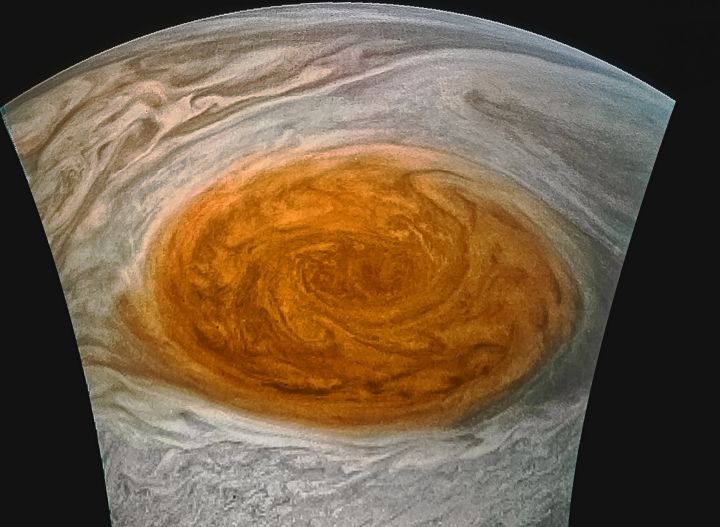Jupiter's Great Red Spot: Everything you need to know

The Great Red Spot is an anticyclone, a long-lasting area of high pressure on Jupiter creating a persistent storm.
Located in Jupiter's Southern Hemisphere, it is the largest storm in our solar system, appearing as a giant red spot on Jupiter's surface. It has existed for the last 150 years, possibly even longer according to NASA.
The spot may have been discovered in 1664 by English scientist Robert Hooke or in 1665 by Italian astronomer Giovanni Cassini, according to the American Physical Society. It is possible one or both men observed either the shadow of one of Jupiter's moons or a different spot. An illustration with a red spot on Jupiter similar to the modern spot appeared in 1831, and the spot has been observed consistently since 1878 when it was re-discovered by American astronomer C.W. Pritchett.
Related: Jupiter's Great Red Spot: Photos of the solar system's biggest storm
How did it form?
The Great Red Spot is an anticyclone, rotating counterclockwise once about every six days, according to The Planets, and produces winds up to 580 mph (933 kph), according to Smithsonian.
On Earth, anticyclones are created when high atmospheric pressure causes air from higher altitudes to be forced down. They are often associated with clear, warm, and dry weather. Cyclones on the other hand form around a central area of low pressure causing air to rise and are associated with cloudy, windy and rainy weather.
While anticyclones don't cause storms on Earth on the same scale as a cyclone, they can contribute to storms and inclement weather conditions, such as Anticyclone Hartmut during the 2018 cold wave in the British Isles, according to Weather and Radar.
Breaking space news, the latest updates on rocket launches, skywatching events and more!
Though scientists understand how anticyclones form on Earth, no one knows for sure exactly how or when the Great Red Spot formed, according to the Planetary Society.
It's also not clear why it is so incredibly long-lived, though scientists have several guesses. One hypothesis is that it is trapped between two opposite-flowing jet streams which act like two conveyor belts, keeping the Great Red Spot spinning on both sides, according to Insider. Another is that the vertical flow of heat and cold inside the storm helps keep it alive. A significant factor in its longevity is the fact that Jupiter, as a gas planet, has no surface, and thus there is no friction to slow the storm, according to JStor Daily.
How big is the Great Red Spot?
The Great Red Spot is 10,159 miles (16,350 kilometers) wide, which is about 1.3 times the width of the Earth (7,918 miles or 12,740 km). However, it used to be far bigger. When it was first observed in detail in the late 19th century it was estimated to have been about 30,000 miles (48,280 km) wide, over three times the width of Earth!
The cause of the Great Red Spot's shrinking remains unknown. It could be that the weather patterns that sustain it have simply lost steam after potentially several hundred years. There is also evidence to suggest that the spot has not only shrunk but grown throughout its history, with some growth recorded through the 1920s, as per NASA.
In addition to shrinking, the spot appears to be changing shape, color, and other characteristics. For example, a 2018 study by scientists at NASA and the University of California, Berkley revealed the storm seems to be growing taller as it shrinks. A few years later, some of the same researchers found that the spot's winds were slowly speeding up.
Given that the reasons for its size reduction are not well understood, it is also unclear how much longer the spot may last. Some research has suggested that it could disappear within one or two decades, but it also may last for centuries.
Great Red Spot facts
- Despite its iconic color, researchers aren't entirely sure what causes the spot to appear red. Some researchers think it could be due to chemicals like ammonia in the upper part of the storm.
- The spot seems to be changing color over time, which researchers also don't understand. Since 2014, it has been taking on a ruddy orange color that is slowly intensifying, according to NASA. The change could be due to changes in the storm's chemical composition or the distribution of gasses within and above it.
- Though Jupiter is very different from Earth, the dynamics governing its storms are similar. Therefore, a better understanding of Jupiter's storms, including the Great Spot Red, could help scientists better understand the weather on Earth.
- The Great Red Spot has a smaller counterpart called the Little Red Spot or Red Spot Jr., which formed between 1998 and 2000 from three white, oval-shaped storms.
- The gasses above the Great Red Spot are hotter than anywhere else on Jupiter, according to a 2016 study. Researchers think the reason for the heating is acoustic waves created by the extreme turbulence of the storm.
Great Red Spot FAQs
What is the Great Red Spot on Jupiter?
The Great Red Spot is a huge elliptical-shaped anticyclone — a long-lasting area of high pressure on Jupiter that creates a persistent storm.
How long will Jupiter's Great Red Spot last?
No one knows for sure. Some research has hypothesized that the spot could disappear in a few decades, but because researchers don't fully understand how and why the spot is changing, it may also last for much longer, possibly many centuries.
How old is Jupiter's Great Red Spot?
It is at least 150 years old and likely much older. It's difficult to confirm if observations in the 17th century were of the same spot we know today, but if they were, the spot would be at least 360 years old, and it's possible it is even older.
Great Red Spot expert Q&A
We asked Amy Simon, NASA planetary scientist, a few questions about Jupiter's Great Red Spot.
Amy Simon is a planetary scientist at NASA Goddard Space Flight Center. She studies the composition, dynamics, and cloud structure of the atmospheres of gas giants like Jupiter, and is the lead scientist of NASA's Hubble Outer Planet Atmospheres Legacy (OPAL) program.
Why do researchers think the Great Red Spot has been shrinking, and also undergoing other changes, like becoming taller?
Rotating storms (cyclones and anticyclones) on Jupiter typically form from a much bigger weather system that condenses down into a distinct storm. Jupiter's alternating pattern of high-speed (and nearly constant) eastward and westward winds act to channel storms and confine them to a latitude band. In the case of the GRS, it almost "rolls" inside that wind channel.
However, the GRS is actually bigger than the channel, meaning it also deflects those winds, and there is a continuous external pressure on it. Over time, the GRS has continued to shrink in both latitude and longitude, and sometimes grows in altitude as it continuously adjusts to balance the internal momentum and the outside winds. What we don't know is at exactly what size and shape a storm may stabilize and for how long. As of early 2023, the GRS is still slightly larger than its latitude channel and spans roughly 10,500 km in latitude and 14,750 km in longitude.
What causes the Great Red Spot's red color, and why might it be changing?
We don't know exactly what gives the GRS its color, which can change from very pale to intensely red-orange. By modeling images acquired at different wavelengths of light, it appears that the colored particles are in the upper hazes near or above the top of the storm. At these altitudes, there are a number of hydrocarbons and other complex molecules that interact with sunlight and can contribute to its distinct coloration; lab studies show that many of these compounds will turn orange when exposed to UV radiation. The exact color of the GRS at any given time often depends on whether fresh clouds (which are white) have been drawn into the storm. Continued monitoring will show if those interactions change as the GRS continues to get smaller.
What kind of historical observations are available about the Great Red Spot, and how can it help us better understand it?
There are continuous observational reports of the GRS back into the mid-1800s, which is a really incredible historical record (Note: early observations in the 1660s also mention a spot, but that spot was much smaller and possibly at a different latitude). From the continuous record, we know that the GRS was much bigger in the 1870s, spanning over 45,000 km in longitude. This long-time span of data is useful for understanding how interactions with the winds may have changed over time, something we are just starting to unravel now using computer simulations of storm size, shape, and motions.
How might understanding more about the Great Red Spot help us understand the weather on Earth?
The GRS is an anticyclone (high-pressure system), and those are not as typical on Earth as cyclones. However, there are mid-Atlantic eddies that can last for several years and provide some analogy to the GRS. The study goes both ways because we can take our much more detailed knowledge of stable Earth storms and see how their behavior and structure apply to Jupiter. On the other hand, we can also study the stability of the GRS as it changes over time to compare with the very different conditions on Earth: land masses, variable high-level winds, etc., that cause storms to dissipate. In essence, we use Jupiter (and all the giant planets) as a fluid dynamics laboratory to understand which conditions most influence storm formation, intensity, and lifetime.
Additional resources
Explore the Great Red Spot in more detail and see how it compares to storms on Earth with these resources on NASA's Juno Mission page. See the Great Red Spot from a different perspective with this artistic interpretation of a Juno mission image. Read more about the Great Red Spot and see how it's perplexed scientists for centuries with this article published in Harvard Magazine.
Editor's note: This story was updated on Nov. 17, 2023, to reflect a change in the description of anticyclones. We had previously reported they can produce supercell thunderstorms and are associated with cold weather. But it is cyclones that can generate these storms under special conditions. Anticyclones are generally associated with clear, warm and dry weather.
Bibliography
Jupiter Red Spot: Facts about the Great Jovian Storm, The Planets. https://theplanets.org/jupiter/jupiter-red-spot-facts/
In Jupiter's swirling Great Red Spot, NASA spacecraft finds hidden depths, NPR
Jupiter's Great Red Spot may only have 10 to 20 years left before it disappears, Business Insider
https://www.businessinsider.com/how-long-jupiter-great-red-spot-will-last-2018-2
May 1664: Hooke vs. Cassini: Who Discovered Jupiter's Red Spot? APS News
https://www.aps.org/publications/apsnews/202005/history.cfm
What Lurks Below Jupiter's Great Red Spot? Smithsonian Magazine
https://www.smithsonianmag.com/smart-news/what-lurks-below-jupiters-great-red-spot-180967524/
Heating of Jupiter's upper atmosphere above the Great Red Spot, Nature

Rebecca Sohn is a freelance science writer. She writes about a variety of science, health and environmental topics, and is particularly interested in how science impacts people's lives. She has been an intern at CalMatters and STAT, as well as a science fellow at Mashable. Rebecca, a native of the Boston area, studied English literature and minored in music at Skidmore College in Upstate New York and later studied science journalism at New York University.

